Covered Calls for Beginners
The images on this post are from the Tastyworks trading platform. I am a personal user of the tastyworks trading platform and believe it is a great choice for anyone who will be trading options, specifically selling options. They not only provide a high-quality product but their support team is amazing. I have emailed them multiple times and receive an answer usually in less than 24 hours! If you have never tried it click this link and give it a try. This is my referral link and will support this blog. Thank you for your continued support!
Table of Contents
ToggleHedging with a Covered Call
Options trading is a great way to diversify your portfolio. As most investors buy and hold there is only one way to make money. The market has to go up. Well, what if the market doesn’t only go up? What should you do to hedge your positions? In this article, we are going to discuss the covered call.

What is Hedging?
Hedging is more than just increasing your home’s curb appeal. Hedging a long stock position means reducing the amount of money you lose if you are wrong about a stock increasing in price. The trade-off of hedging is you could reduce the amount you make if you are right. It’s a trade-off that is usually well worth it, especially if you are worried about downside risk to your stock positions.
What is a covered call
A covered call is quite simple and consists of only 2 parts. First, you will need 100 shares of your favorite stock. Second, you will need to short one call option on the same stock.
Step 1: Buy 100 shares of your favorite stock
Step 2: Sell an out of the money call on the same stock
A short call option
What does it mean to have a short call option? Being short an option contract means you are selling an option contract and receiving a credit to do so. When you are short a call option you are offering to sell 100 shares of stock at the strike price. This will be set to happen on the date the option contracts expire. When selling options you must choose a strike price and an expiration date.
Let's look at an example of a covered call strategy
I own 100 shares of XYZ at $100 a share. To reduce my downside losses I sell the $105 strike call that expires in 25 days. By selling that call I receive $1.75 per share or $175 in total option premium. This reduces my dollar cost average on XYZ to $98.25 a share, reducing my downside risk.
If the stock price drops or stays below $105 when the call expires in 25 days, you get to keep the $175 credit and your 100 shares! This is a great way to generate income on the shares you already own. Investment strategies like this have the potential to beat standard buy-and-hold investing.
The trade-off
For that added downside protection there is of course a trade-off. If the stock price rises you will be giving up some upside potential. Looking at the example above, if the underlying XYZ stock jumps to $115 a share I will be forced to sell my shares at $105 a share, missing out on $500 worth of profit. Don’t get me wrong this is a good problem to have, but can be very hard to stomach when it happens to you. You could always buy back the call for a loss of approx $500 and keep your shares but either way you’re cutting into your profits.
Another issue that comes with covered calls, is when the stock drops a significant amount from your purchase price. As the stock price continues to fall, selling covered calls becomes much more difficult. The
If the stock price does rise above your short call and you lose your shares don’t fret! Instead of buying your shares back, you can try another strategy I love using. Check out my post on Cash Secured Puts as another investment strategy you can add to your arsenal!
When is the best time to sell a covered call?
There is no best time to sell covered calls but there are a few strategies I like to use when selling covered calls.
The first strategy is when stocks hit all-time highs or new recent highs. If you sell a 25 delta call there is approximately a 75% chance that the call will expire worthless. On top of that, if you do end up having your stock called away you will be doing it when the stock is at new highs locking in that profit. The only downside, I find, to this strategy is you will be selling a call during times of very low volatility making the option price of the calls very cheap.
The other strategy is to base your call selling on the current volatility of the market. As volatility (also known as the VIX) increases so does the price of the call options.
If you sell at a time of high volatility you will be able to collect more credit as well as a strike price further from the current price of the stock. If I feel volatility is high and downside protection is needed I will sell a call very close to at the money(ATM).
This provides me with a large credit as well as a good amount of downside protection. Of course, at the same time this will cap my profit potential for the stock at the current price, a risk I’m willing to take.
What are the risks of a covered call?
The answer to these questions mostly depends on how close to ATM you sell your call. The closer your call is to “at the money” the lower your delta will be. If you own 100 shares of stock XYZ your delta is 100, meaning for every dollar the underlying stock price goes up, your position will gain $100. If you were to sell an ATM call with a delta of approx 50, your delta would be reduced to 50 (100 – 50).
This means your position is still bullish and will make money if the stock goes up, and lose less money if the stock goes down. Many believe a covered call is a bearish position; when it would be considered a hedge against a bullish position. Let’s look at a visual representation of a covered call and its profit zones.
This may be a bit confusing at first but the green and red shaded areas are the loss/profit zones today, and the lined area is the profit/loss on expiration. Here we are buying 100 shares at 103.83 and selling a 110 call for $3.50. Our downside break-even point would be (103.83-3.50) $100.33. While our max profit would be (110-103.83+3.50) $9.67 or $967. As you can see there is still profit to be made even if the stock blows through your short call, this is because of this position’s positive delta. As the stock continues to increase your delta will drop. As you close in on max profit it is best to redeploy your capital elsewhere and not wait for the option to expire.
How does volatility affect the price of a covered call
Hedging with options can be a powerful tool to protect your portfolio from volatility. By understanding how options are priced, you can better assess which options strategies make the most sense for your goals.
The price of an option is made up of two main components: the intrinsic value and the time value. The intrinsic value is the in-the-money amount, or the amount that the option would be worth if it were exercised immediately. The time value is the portion of the premium that compensates the seller for bearing the risk until expiration.
Volatility is one of the biggest factors affecting the price of an option. When the stock market is unstable, option premiums go up because there is a higher possibility that the security will fluctuate enough to make the option profitable.
What does this mean for us?
This means as sellers of options, we want to sell covered calls during times of high volatility. The problem with covered call writing is that the best time to write a covered call doesn’t coincide with the times of the highest volatility. Usually when stocks are at their highest is the same time that volatility is at its lowest. This makes selling covered calls not as straightforward as just waiting for high volatility.
At the money call strategy
This means that, unlike other option strategies, opening a covered call position does not have to rely on volatility alone. You can play around with your position entries. If you got into a stock at a really good price and it recently dropped, you could attempt to “lock in” profit by selling an at-the-money call for a high premium. You can even sell a slightly in-the-money covered call to increase the premium and increase the likelihood that your position will be called away.
How to execute a covered call trade
Find a stock that you like
When it comes to picking stocks, one of the most important things you can do is find a company with a solid foundation. By that, we mean a company that is profitable and has a good track record.
A company with a strong foundation is more likely to be successful in the long run, which means you’re less likely to lose money if you invest in it. So how do you go about finding such companies?
One way is to look at financial reports and other data that measure a company’s performance over time. Another way is to talk to experts or read news articles about the stock market. Sticking with the big names we all know and love is also a great place to start!
Decide how bullish you are on that stock(Delta)
The next step is to decide how far out of the money you will choose to sell your call. This depends on the current stock price, market volatility, and premium received.
It is usually not worth selling a call so far out of the money that you are only receiving a few dollars in premium. If you are afraid of the stock being “called away” from you then you should not be looking at selling a covered call.
ATM call vs Cash Secured Put
If you feel the stock is likely to see a downturn soon, then selling a call closer to the stock price that you paid makes a lot of sense. If this is an opening position where you are buying 100 shares as well as selling an ATM call, let me give you a little tip. It is usually better to sell a cash secured put instead. Puts tend to be more expensive than calls and this will provide you with more premium while giving you better profit potential. Below you can see how they are very similar, if you look at the bottom of each picture you can see P50(probability of 50% profit) and buying power effect (BP Eff). Even though the max profit and loss are similar the Short Put has a better P50 and less BP eff.
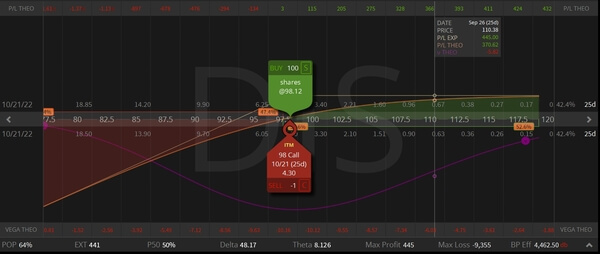
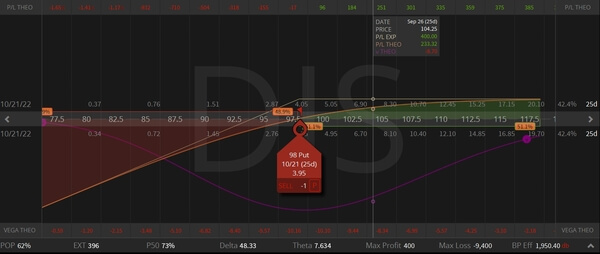
Decide how far out in time to sell a call
This goes along with the previous step but I wanted to give it it’s own area to talk about. There are two schools of thought when it comes to selling options.
Tastyworks suggests 45 days to expiration for selling premium and they have a ton of data backing that up. More patience is required, however, your gains and losses won’t fluctuate as rapidly. This will allow you to stay in trades longer and not get scared out of them.
The other option is selling weekly options 7-14 days out. I like this option a bit better but that is only because I am a very impatient person. If you like to look at the market daily and can make adjustments quickly this could be a strategy for you.
Adjust your position as needed
Adjusting your covered calls is more of an art than a science. There are some hard and fast rules, like not waiting until the day of expiration to make adjustments. Everything else you are going to have to learn by trial and error, but I do have a few tips for you.
Roll before your call goes ITM
When rolling calls it is better to do it sooner than later. If you can roll your call out in time and up in strike price before it has been breached you will be better off. You can tend to roll for more credit the sooner you do it. This allows you to collect more premium or roll your strike further up than if you had waited.
Patience is key
If your stock has gone on a run, and your call is ITM early in the trade, don’t panic! You are actually in a great position and should give the trade some time to work out. Many times I would exit these positions too quickly and the stock would continue higher or do nothing at all. Had I stayed in the position longer, I could have collected more premium or made more on the stock price continuing higher.
Don't roll your calls down too far
If you entered a position that is just not working out for you, and the stock price just continues lower… beware! You may have the urge to chase the stock price down, trying to collect as much premium as possible, but you may be locking in a loss.
If you continue to roll down your calls past the entry price of your stock you could be setting yourself up for failure. If the premium collected is less than the distance between your entry price and the current strike price, you will have locked in a loss. The only way out is to continue to roll out in time and hope the stock bounces.
An example of my own
Many times instead of rolling down, it is best to either exit the position for a loss or allow the stock to bounce before entering another call position. As you can see below, my GOOG position is not going well for me. For me to sell a call at least my entry price, I will only be collecting $10 in premium. This is simply not worth it, and I need to either exit for a loss or wait it out for better premiums!
The above references an opinion and is for information purposes only. It is not intended to be investment advice. Is the covered call something that you guys have tried in the past? What are your thoughts about it? Comment below some of your favorite covered call strategies!



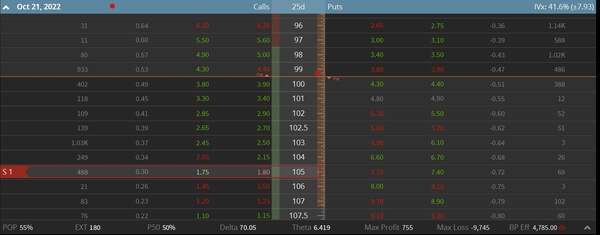
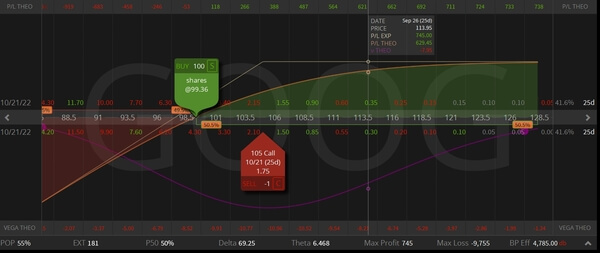
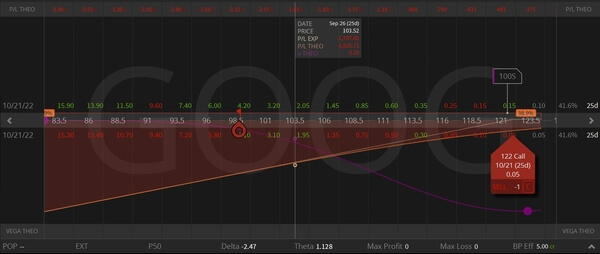






you have a great blog here! would you like to make some invite posts on my blog?